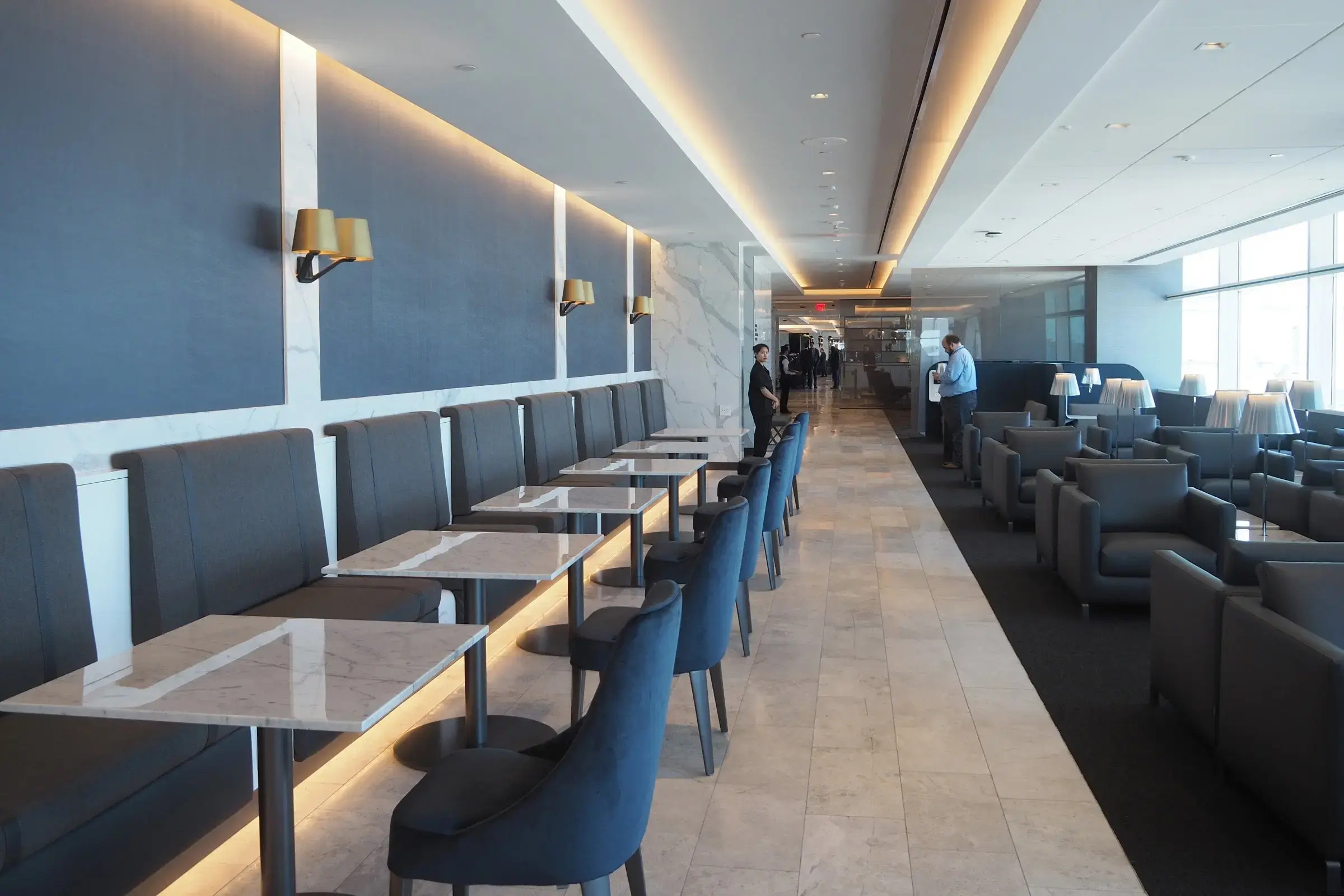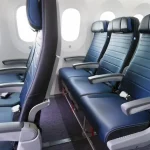Key Takeaways
- SFO takes the crown for overall experience, larger space, better dining room, outdoor terrace, and consistently higher service standards.
- Newark wins for East Coast convenience but suffers from crowding during evening Europe departure banks.
- Dining quality: SFO’s restaurant-style service edges out Newark’s improved but still inconsistent dining room • Strategic routing: Choose SFO for Asia travel and leisure trips, Newark for business travel to Europe.
The Real Difference Between United’s Flagship Polaris Lounges
After experiencing both lounges multiple times and tracking feedback from our TalkTravel community, SFO’s Polaris lounge delivers a consistently superior experience, though Newark has made significant improvements since its 2018 opening. But the “better” choice depends heavily on your routing, timing, and what you value most in a premium lounge experience.
Here’s what most comparison articles miss: The lounges serve fundamentally different travel patterns, and understanding these patterns matters more than abstract amenity comparisons. SFO primarily serves leisure travelers heading to Asia and tech business travelers with flexible schedules. Newark caters to financial services professionals, consultants, and corporate travelers with rigid East Coast schedules and Europe-heavy routing.
This difference shapes everything from crowd patterns to service philosophy to dining quality. SFO feels designed for relaxation and extended stays, while Newark optimizes for efficiency and quick premium service before transatlantic flights.
Both lounges represent massive improvements over their predecessors and rank among the best business class lounges globally. But after analyzing dozens of visit reports from frequent flyers, the nuances matter enormously for your specific travel needs.
| Feature | SFO Polaris Lounge | Newark Polaris Lounge |
| Size | Largest Polaris lounge (~28,000 sq ft, 2 floors) | Smaller, recently expanded |
| Location | Terminal 3, near Asia/Europe gates | Terminal C, near Europe gates, terminal transfer may be needed |
| Dining | Upscale restaurant-style à la carte dining | Efficient, quality business lounge dining |
| Amenities | Outdoor terrace, shower suites, nap rooms | Shower suites, business-friendly seating |
| Crowding Patterns | Spread out, manageable, peak 6-8 PM | Crowded peak Europe departure evenings |
| Ideal For | Leisure travelers, Asia routes | Business travelers, Europe routes |
Location and Accessibility Showdown
San Francisco International (SFO)
Terminal 3, International Boarding Area G – The SFO Polaris lounge sits in the heart of United’s international operations, easily accessible after clearing security. The location puts you steps from most Asia and Europe departure gates, with clear sightlines to departure boards throughout the facility.
Access strategy: Most travelers find the lounge within 5 minutes of clearing international security. The entrance is well-marked and staffed consistently, with rarely any confusion about eligibility or location.
Connection efficiency: If you’re connecting domestically before international departure, the location works perfectly. Domestic-to-international connections through SFO flow naturally past the lounge entrance.
Newark Liberty (EWR)
Terminal C, past security checkpoint – Newark’s Polaris lounge replaced the old United Club in the same general area, positioning it well for Europe departures but requiring more navigation from arrival gates.
Access considerations: The lounge entrance can be crowded during peak evening hours when multiple Europe flights begin boarding simultaneously. Staff handles the crowds professionally, but expect brief waits during 6-8 PM peak periods.
Terminal layout: Newark’s Terminal C layout makes the lounge easily accessible from most United gates, though the facility feels more integrated into the gate area than SFO’s somewhat separate, destination-like location.
Dining Experience Comparison
SFO’s Restaurant-Style Advantage
The dining room at SFO operates more like an actual restaurant , with dedicated servers providing attentive table service and higher-quality food preparation. Community feedback consistently praises the dining room experience as worth requesting upon arrival, even during busy periods.
Menu quality and execution: The à la carte dining at SFO features restaurant-caliber entrees with proper plating and presentation. Items like seared duck breast and craft cocktails reflect genuine culinary attention rather than upgraded airline catering.
Service philosophy: SFO’s dining room staff treat the experience as upscale restaurant service, taking time with recommendations and ensuring proper pacing between courses. This approach works well for travelers with 2+ hours before departure.
Newark’s Efficiency-Focused Approach
Newark’s dining room shows improvement over initial reviews but operates more as an enhanced business lounge restaurant than SFO’s destination-dining approach. The Points Guy noted staffing issues in the Dining Room during early operations though these have largely been resolved based on recent community reports.
Corporate traveler optimization: Newark’s dining focuses on high-quality but quickly-served options suitable for business travelers with tight connection windows or specific departure times. Less leisurely than SFO, but more predictable for scheduling.
Crowding management: The smaller dining room at Newark gets overwhelmed during peak Europe departure periods, making reservations essential and sometimes creating 60+ minute waits during busy evenings.
Amenities and Layout Analysis
SFO’s Comprehensive Facilities
Outdoor terrace access provides a unique feature unavailable at Newark or most other Polaris lounges. The terrace offers runway views and fresh air breaks during long layovers, particularly valuable during extended Asia routing connections.
Sleep pod availability: SFO features dedicated quiet areas with lie-flat seating designed for extended stays between long-haul flights. Given the typical 12+ hour flights departing SFO for Asia, these facilities get heavy use but remain well-maintained.
Shower suite operations: Multiple shower facilities with consistent availability and high-quality amenities. The shower suites book up during peak periods but rarely create the availability issues seen at smaller lounges.
Newark’s Business-Traveler Focus
Expanded facility improvements: Newark represents “a huge improvement over the United Club that occupied this space” with purpose-built Polaris amenities rather than converted existing facilities.
Work-focused layout: More individual seating and work surfaces designed for laptop use and business calls, reflecting the corporate-heavy passenger mix departing Newark for Europe business destinations.
Efficient amenity access: Shower facilities and other premium amenities are positioned for quick access and turnover, suitable for travelers with shorter connection windows typical of East Coast business routing.
Crowding Patterns and Timing Strategy
SFO’s Leisure-Business Mix
Peak crowding occurs 6-8 PM during the evening Asia departure bank, but the larger facility and leisure traveler mix creates more predictable crowd flow. Travelers often arrive early and stay longer, creating steady but manageable occupancy.
Seasonal variations: Summer leisure travel and tech conference periods create higher demand, but the facility size and multiple departure waves spread crowds more effectively than Newark’s concentrated Europe banks.
Strategic timing: Arriving 2-3 hours early provides excellent access to all amenities without significant crowding concerns, especially outside summer peak periods.
Newark’s Corporate Rush Periods
Evening Europe departures create intense crowding as corporate travelers arrive simultaneously for 7-10 PM transatlantic flights. The concentrated departure pattern puts pressure on dining reservations and popular amenities.
Weekday vs weekend patterns: Monday-Thursday evenings show the most crowding, while weekend periods offer better amenities access and shorter wait times for dining services.
Connection timing strategy: If connecting through Newark, plan for longer lounge waits during weekday evening peaks or arrive during off-peak afternoon hours for better experience quality.
Route-Specific Strategic Considerations
When SFO Makes More Sense
Asia routing advantages: Longer typical flight times (12-16 hours to Asia vs 7-8 hours Europe from Newark) make the enhanced SFO dining and relaxation amenities more valuable. The outdoor terrace and extended seating options justify longer pre-flight stays.
Leisure travel optimization: SFO’s location and amenities cater better to vacation travelers with flexible schedules who can arrive early and enjoy the full lounge experience without corporate time pressures.
Premium cabin targeting: Routes from SFO show better Polaris upgrade clearing rates to Asia destinations, making the lounge investment more likely to pay off through successful upgrades.
When Newark Provides Better Value
Europe business travel efficiency: Shorter flight times and tighter corporate schedules make Newark’s efficiency-focused amenities more practical than SFO’s leisurely approach.
East Coast convenience: Geographic location eliminates cross-country positioning flights, saving time and money for travelers based in the Northeast corridor.
Corporate travel integration: Newark’s amenities and service style align better with business travel patterns and expense account expectations common among Europe-bound corporate travelers.
The Practical Bottom Line
For most travelers, SFO delivers the superior Polaris lounge experience through better dining, more space, unique amenities like the outdoor terrace, and more consistent service standards. The larger facility handles crowds better and provides more flexibility for different travel styles.
Newark serves its purpose excellently for East Coast business travel but operates more as a premium airport lounge than a destination experience. If you’re connecting through Newark for Europe business travel, the lounge provides excellent value and service – just don’t expect the same leisurely, resort-like experience that SFO delivers.
Strategic routing recommendation: Choose SFO routing when possible for leisure travel and Asia destinations where you can utilize the enhanced amenities. Use Newark for Europe business travel where efficiency matters more than extended luxury, or when East Coast positioning makes geographic sense.
The “better” choice ultimately depends on your travel patterns, but SFO edges ahead for most travelers seeking the premium lounge experience that Polaris lounges promise to deliver.
Want to share your own SFO vs Newark lounge experiences and get real-time crowding reports? Join our United Polaris Lounge Comparison forum where travelers post detailed facility reviews and strategic routing advice.
FAQs
Which lounge is larger, SFO or Newark?
SFO operates a significantly larger facility with more diverse seating areas, though both lounges accommodate their respective passenger loads well during normal periods.
Do both lounges offer the same dining room experience?
Both have full-service dining rooms, but SFO provides more restaurant-style service while Newark focuses on efficient, high-quality business lounge dining.
Which lounge gets more crowded during peak times?
Newark experiences more concentrated crowding during weekday evening Europe departures, while SFO’s crowds spread more evenly across longer time periods.
Are the shower facilities comparable between locations? Both offer high-quality shower suites, but SFO typically has better availability due to larger facility size and more distributed usage patterns.
Which lounge is better for business travelers vs leisure travelers?
Newark optimizes for efficient business travel needs, while SFO provides a more comprehensive leisure-oriented premium experience with extended stay amenities.
Keep going
Related guides on TalkTravel:





